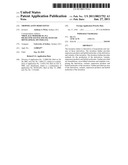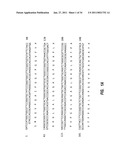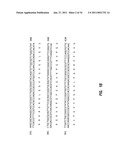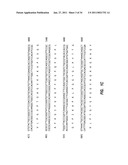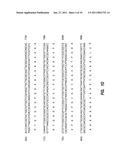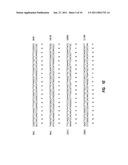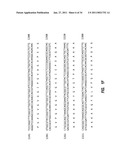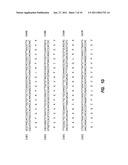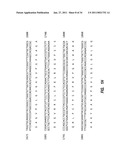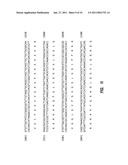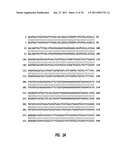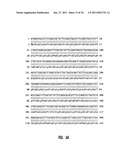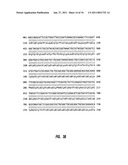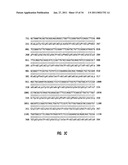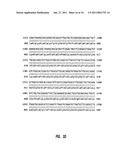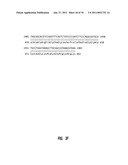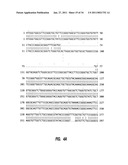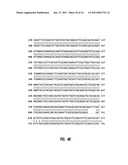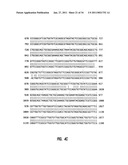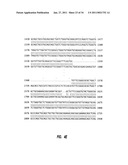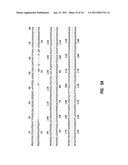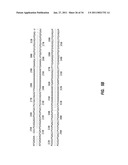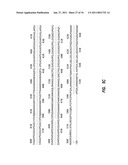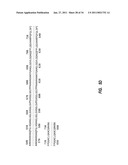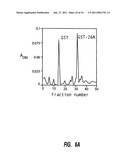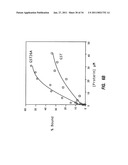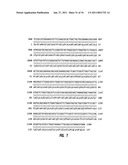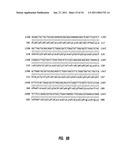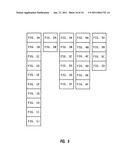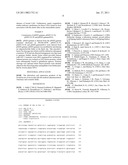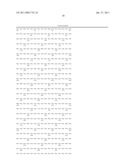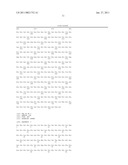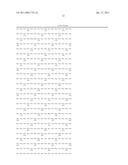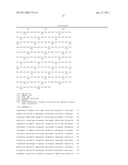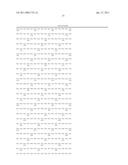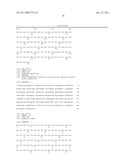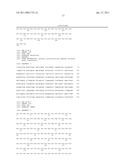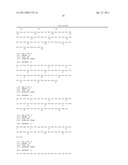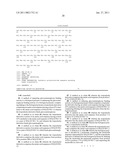Patent application title: Tropoelastin Derivatives
Inventors:
Anthony S. Weiss (Sydney, AU)
Assignees:
University of Sydney
IPC8 Class: AC07K1478FI
USPC Class:
530353
Class name: Chemistry: natural resins or derivatives; peptides or proteins; lignins or reaction products thereof proteins, i.e., more than 100 amino acid residues scleroproteins, e.g., fibroin, elastin, silk, etc.
Publication date: 2011-01-27
Patent application number: 20110021752
Claims:
1-81. (canceled)
82. A method of imparting glycosaminoglycan binding activity to a biological polymer or enhancing the glycosaminoglycan binding activity of a biological polymer, comprising linking to the biological polymer a tropoelastin derivative comprising an amino acid sequence having at least 65% similarity to the amino acid sequence of SEQ ID NO: 12 wherein the tropoelastin derivative binds glycosaminoglycan.
83. A method as in claim 82 wherein the tropoelastin derivative consists of an amino acid sequence having at least 65% similarity to the amino acid sequence of SEQ ID NO: 14 or a part of SEQ ID NO: 14, and wherein the tropoelastin derivative binds glycosaminoglycan.
84. A method as in claim 82 wherein the tropoelastin derivative consists of an amino acid sequence of SEQ ID NO: 14 or a part of SEQ ID NO: 14, which binds glycosaminoglycan.
85. A method as in claim 82 wherein the tropoelastin derivative comprises the amino acid sequence from position 10 to position 200 of SEQ ID NO: 9.
86. A method as in claim 82 wherein the tropoelastin derivative comprises the amino acid sequence of SEQ ID NO: 12.
87. A method as in claim 82 wherein the tropoelastin derivative comprises the amino acid sequence from position 1 to 33 of SEQ ID NO: 12.
88. A method of reducing glycosaminoglycan binding activity of a biological polymer which comprises a tropoelastin derivative having an amino acid sequence having at least 65% similarity to the amino acid sequence of SEQ ID NO: 12, comprising deleting the tropoelastin derivative from the biological polymer.
89. A method as in claim 88 wherein the tropoelastin derivative has the amino acid sequence from position 1 to position 33 of SEQ ID NO: 12.
90. A method as in claim 88 wherein the tropoelastin derivative has the amino acid sequence of SEQ ID NO: 12.
91. A method as in claim 88 wherein the biological polymer is a tropoelastin molecule.
92. A method as in claim 91 wherein the tropoelastin molecule comprises the amino acid sequence of SEQ ID NO: 2.
93. A method as in claim 88 wherein the biological polymer is encoded by a nucleotide comprising the nucleotide sequence represented by SEQ ID NO: 1, and the tropoelastin derivative is deleted from the biological polymer by deleting from the nucleotide the nucleotide sequence from position 1678 to position 1776 of SEQ ID NO: 1 and expressing the nucleotide in a host cell.
Description:
[0001]The present application is a divisional application of application
Ser. No. 11/880,320, filed Jul. 20, 2007, which is a continuation of
application Ser. No. 11/053,710, filed Feb. 8, 2005, which is a
continuation of application Ser. No. 09/463,091, filed Mar. 31, 2000
which, in turn, claims priority under 35 USC 371 based on PCT Application
PCT/AU98/00564, filed Jul. 17, 1998.
TECHNICAL FIELD
[0002]The present invention relates to derivatives of human tropoelastin and variants thereof, to genetic constructs encoding the amino acid sequences of the derivatives and variants and to uses of the derivatives and variants. In particular, the derivatives of the present invention have elastin-like properties or macro-molecular binding properties.
BACKGROUND ART
[0003]There are various forms of tropoelastin that typically appear to consist of two types of alternating domains: those rich in hydrophobic amino acids (responsible for the elastic properties) and those rich in lysine residues (responsible for cross-link formation). Hydrophobic and cross-linking domains are encoded in separate exons (Indik et al 1987).
[0004]The 26 A region of human tropoelastin is unique amongst tropoelastin domains in that, due to the absence of lysine, this region does not participate in elastin cross-link formation. Furthermore, this region is a serine-rich domain and lacks hydrophobic stretches, indicating that it is unlikely to contribute to the elasticity of tropoelastin. There is otherwise limited information on the structure and functional relationships of the 26 A region (Bedell-Hogan et al., 1993).
[0005]The gene for tropoelastin is believed to be present as a single copy in the mammalian genome, and is expressed in the form of multiple transcripts, distinguished by alternative splicing of the pre-mRNA (Indik et al, 1990; Oliver et al, 1987). Modest expression of a natural human tropoelastin sequence has been achieved by Indik et al (1990) using cDNA, providing free polypeptide which unfortunately was unstable.
[0006]Expression of substantial amounts of human tropoelastin using synthetic polynucleotides is reported in WO94/14958. In particular, a construct, SHEL, providing substantial amounts of full length human tropoelastin is described.
DESCRIPTION OF THE INVENTION
[0007]In the specification and claims, "derivatives of human tropoelastin" or "tropoelastin derivatives" means novel peptides, polypeptides or proteins which contain amino acid sequences derived from the native amino acid sequences of human tropoelastin molecules. The amino acid sequences of the derivatives of human tropoelastin may be derived from any of the amino acid sequences of the isoforms of human tropoelastin. Derivatives of human tropoelastin are distinguished from human tropoelastin molecules in that the amino acid sequences of derivatives are altered with respect to native tropoelastin sequences by substitution, addition or deletion of residues, or a combination of these alterations, in derivative amino acid sequences.
[0008]In a first aspect, the present invention provides derivatives of human tropoelastin which have elastin-like properties. Elastin-like properties are a combination of elastic properties, including the phenomenon of recoil following molecular distention under appropriate conditions, and the ability to be cross-linked to other elastin molecules and/or other elastin-like molecules.
[0009]In a second aspect, the present invention provides derivatives of human tropoelastin which have macro-molecular binding properties including the ability to bind glycosaminoglycans.
[0010]In a third aspect, the present invention provides derivatives of human tropoelastin which have elastin-like properties and macro-molecular binding properties.
[0011]The present invention further provides amino acid sequence variants of the derivatives of the invention. In the specification and claims "variants" means amino acid sequences which retain the properties of the corresponding derivative of human tropoelastin, for example, elastin-like properties or macro-molecular binding properties, or a combination of elastin-like properties and macro-molecular binding properties, and have an amino acid sequence which is homologous with the amino acid sequence of the corresponding derivative. For the purposes of this description, "homology" between the amino acid sequence of a particular derivative of human tropoelastin and another amino acid sequence connotes a likeness short of identity, indicative of a derivation of one sequence from the other. In particular, an amino acid sequence is homologous to a derivative of human tropoelastin if the alignment of that amino acid sequence with the sequence of the derivative of human tropoelastin reveals a similarity of about 65% over any 20 amino acid stretch or over any repetitive element of the molecules shorter than 20 amino acids in length. Such a sequence comparison can be performed via known algorithms, such as that of Lipman and Pearson (1985). Similarity is observed between amino acids where those amino acids have a side chain which confers a similar chemical property in the same chemical environment. For example, threonine and serine are similar amino acids; aspartic acid and glutamic acid are similar amino acids; valine, leucine and isoleucine are similar amino acids etc. Thus, an amino acid sequence may be considered homologous with the amino acid sequence of a human tropoelastin derivative because the alignment of those sequences reveals a similarity of 65%, although at each amino acid position in the aligned sequences, none of the residues are identical.
[0012]Inasmuch as the present invention provides derivatives of human tropoelastin and amino acid sequence variants of those derivatives, the invention thus extends to amino acid sequence variants incorporating amino acid sequences of non-human tropoelastins. Amino acid sequence variants which are non-human tropoelastin derivatives, or are based all, or in part, on non-human tropoelastin derivatives retain properties of the corresponding derivative of non-human tropoelastin, for example, elastin-like properties or macro-molecular binding properties, or a combination of elastin-like properties and macro-molecular binding properties, and have an amino acid sequence which is homologous with the amino acid sequence of the corresponding human derivative. The variants of the invention also include variants of the non-human tropoelastin derivatives, or of derivatives based on the non-human tropoelastin derivatives. "Homology" between the amino acid sequence of a particular derivative of non-human tropoelastin and another amino acid sequence connotes a likeness short of identity, indicative of a derivation of one sequence from the other. In particular, an amino acid sequence is homologous to a derivative of non-human tropoelastin if the alignment of that amino acid sequence with the sequence of the derivative of non-human tropoelastin reveals a similarity of about 65% over any 20 amino acid stretch or over any repetitive element of the molecules shorter than 20 amino acids in length. The skilled addressee will understand that species that are substantially phylogenetically related to humans express tropoelastin molecules which consist of amino acid sequences with homology to human tropoelastin amino acid sequences. Indeed, amino acid sequences of non-human tropoelastins have been determined, including the amino acid sequences of chick tropoelastin, bovine tropoelastin and rat tropoelastin (Bressan et al. 1987, Raju et al. 1987, Pierce et al 1992) and over multiple regions, these are homologous with the human tropoelastin amino acid sequences. The skilled addressee will recognise therefore, that derivatives of human tropoelastin and amino acid sequence variants of those derivatives will necessarily encompass corresponding tropoelastin amino acid sequences from these and other non-human species.
[0013]The present invention provides a tropoelastin derivative comprising the amino acid sequence of SHELδmodified (SEQ ID NO:5). The amino acid sequence of SHELδmodified and the alignment of that amino acid sequence with the human tropoelastin sequence is shown in FIG. 5.
[0014]The invention also provides an amino acid sequence variant of the derivative comprising the amino acid sequence of SHELδmodified.
[0015]The invention also provides a polynucleotide encoding a tropoelastin derivative comprising the amino acid sequence of SHELδmodified. The nucleotide sequence encoding SHELδmodified is shown in FIG. 3 (SEQ ID NO: 4). Preferably the polynucleotide comprises the nucleotide sequence which corresponds to SHELδmodified shown in FIG. 3.
[0016]The invention also provides a polynucleotide encoding an amino acid sequence variant of the derivative SHELδmodified.
[0017]The present invention further provides a synthetic polynucleotide encoding a tropoelastin derivative comprising the amino acid sequence of SHELδ26A (SEQ ID NO:3). A synthetic polynucleotide is a molecule which comprises a nucleotide sequence that contains silent mutations with respect to the corresponding native polynucleotide molecule. The silent mutations enhance the expression of the synthetic polynucleotide. The amino acid sequence of SHELδ26A and the alignment of that amino acid sequence with the human tropoelastin sequence is shown in FIG. 2. The SHELδ26A derivative excludes the SHEL coding sequence corresponding to exon 26A. Preferably the synthetic polynucleotide comprises the sequence shown in FIG. 1 (SEQ ID NO:1) from nucleotide position 1 to 1676 contiguous with nucleotide position 1775 to 2210.
[0018]The invention also provides a polynucleotide encoding an amino acid sequence variant of the derivative SHELδ26A.
[0019]The invention also provides an amino acid sequence variant of the derivative comprising the amino acid sequence of SHELδ26A.
[0020]The present inventor has, for the first time, shown that the region encoded by exon 26A (peptide 26A) of the tropoelastin gene binds glycosaminoglycans (GAGs) (FIGS. 6A and B). GAGs are macro-molecules particularly associated with the extracellular environment. These molecules play an important role in the architecture and mechanical properties of connective tissues and mediate interactions with and availability of other molecules.
[0021]Thus, the present invention provides a tropoelastin derivative comprising the amino acid sequence of peptide 26A. Peptide 26A has the amino acid sequence:
TABLE-US-00001 (SEQ ID NO: 12) GADEGVRRSLSPELREGDPSSSQHLPSTPSSPRV or (SEQ ID NO: 13) GADEGVRRSLSPELREGDPSSSQHLPSTPSSPRF.
[0022]The present invention also provides an amino acid sequence variant of the derivative comprising the amino acid sequence of peptide 26A.
[0023]The invention also provides a polynucleotide encoding a tropoelastin derivative comprising the amino acid sequence of peptide 26A. Preferably the polynucleotide comprises the nucleotide sequence shown in FIG. 1 (SEQ ID NO: 1) from nucleotide position 1687 to 1778. Preferably the 3 terminal codon is GTT (which encodes V) or TTT (which encodes F).
[0024]The invention also provides a polynucleotide encoding an amino acid sequence variant of the derivative comprising the amino acid sequence of peptide 26A.
[0025]In appreciating the GAG binding property of peptide 26A, the present inventor envisages the generation of novel subsets of hybrid molecules, comprising biological polymers which are linked to peptide 26A, wherein the peptide 26A imparts GAG binding activity to the polymer. In particular, the present inventor has recognised that the deletion or insertion of the peptide 26A amino acid sequence, or a variant of that amino acid sequence will alter GAG binding activity. Thus, the present invention relates to tropoelastin derivatives in which full length or partial length tropoelastin molecules have been modified by the addition of one or more exon 26A regions to enhance interactions with GAGs. Moreover, the invention relates to site directed modification of the amino acid sequence of peptide 26A so as to generate variants of the peptide 26A amino acid sequence which have altered affinity or altered specificity for GAGs. Tropoelastin derivatives or variants of the derivatives which contain altered GAG binding activity may be uncross-linked or cross-linked.
[0026]In another aspect, the invention provides a hybrid molecule. In the specification and claims, "hybrid molecule" means a molecule comprising a biological polymer which is linked to a tropoelastin derivative comprising the amino acid sequence of peptide 26A or an amino acid sequence variant of a derivative comprising the amino acid sequence of peptide 26A. Preferably the biological polymer is a protein. More preferably the protein is selected from the group consisting of growth factors, cytokines and antibodies. Alternatively the biological polymer is selected from the group consisting of lipids, sugars or nucleic acids.
[0027]In one embodiment, and where the biological polymer is a protein, the hybrid molecule is produced by recombinant DNA techniques, including for example the construction of a nucleotide sequence which encodes the biological polymer and the tropoelastin derivative comprising the amino acid sequence of peptide 26A, or the amino acid sequence variant of a derivative comprising the amino acid sequence of peptide 26 A, in a single open reading frame. Alternatively, the hybrid molecule may be produced synthetically by solid phase peptide synthesis, including, for example the methods of synthesis disclosed in Merrifield (1963) or Knorr et al. (1989). Examples of peptide synthesis also include the synthesis methods used by peptide synthesisers of Perkin Elmer/Applied Biosystems, CA, US.
[0028]In another aspect, the invention provides a polynucleotide sequence encoding a hybrid molecule of the invention.
[0029]In another aspect, the invention provides a hybrid molecule which comprises a synthetic polymer which is linked in a tropoelastin derivative comprising the amino acid sequence of peptide 26A, or an amino acid sequence variant of the derivative comprising the amino acid sequence of peptide 26A.
[0030]The invention further provides a method of imparting or enhancing GAG binding activity to a biological polymer comprising the step of linking a tropoelastin derivative comprising the amino acid sequence of peptide 26A, or an amino acid sequence variant of peptide 26A with the biological polymer. Preferably the biological polymer is a protein.
[0031]The invention further provides a method of deleting or reducing GAG binding activity from a biological polymer comprising the step of deleting a tropoelastin derivative comprising the amino acid sequence of peptide 26A, or an amino acid sequence variant of peptide 26A from the biological polymer. Preferably the biological polymer is a protein.
[0032]The present invention also provides a tropoelastin derivative comprising the amino acid sequence of SHELgamma. SHELgamma has the amino acid sequence:
TABLE-US-00002 (SEQ ID NO: 9) 1 SAMGALVGLGVPGLGVGAGVPGFGAGADEGVRRSLSPELREGDPSSSQHL PSTPSSPRVPGALAAAKAAKYGAAVPGVLGGLGALGGVGIPGGVVGAGPA AAAAAAKAAAKAAQFGLVGAAGLGGLGVGGLGVPGVGGLGGIPPAAAAKA AKYGAAGLGGVLGGAGQFPLGGVAARPGFGLSPIFPGGACLGKACGRKR K.
[0033]The invention also provides an amino acid sequence variant of the derivative comprising the amino acid sequence of SHELgamma.
[0034]The invention also provides a polynucleotide encoding a tropoelastin derivative, the derivative comprising the amino acid sequence of SHELgamma. The nucleotide sequence of the polynucleotide SHELgamma (SEQ ID NO: 8) is shown in FIG. 8. In this nucleotide sequence, the first 9 codons from nucleotide position 948 to 974 are derived from the glutathione S-transferase (GST) fusion nucleotide sequence. Preferably the polynucleotide comprises the nucleotide sequence shown in FIG. 8. More preferably the polynucleotide comprises the nucleotide sequence shown in FIG. 8 from nucleotide sequence position 975 to 1547.
[0035]The invention also provides a polynucleotide encoding an amino acid sequence variant of the derivative comprising the amino acid sequence of SHELgamma.
[0036]The present invention also provides a polynucleotide encoding a tropoelastin derivative, the derivative comprising the amino acid sequence of SHELgamma excluding exon 26A. The nucleotide sequence of the polynucleotide SHELgamma excluding exon 26A (SEQ ID NO: 6) is shown in FIG. 7. In this nucleotide sequence, the first 5 codons from nucleotide position 948 to 962 are derived from the GST nucleotide sequence. SHELgamma excluding exon 26A has the following amino acid sequence:
TABLE-US-00003 (SEQ ID NO: 7) 2 VPGALAAAKAAKYGAAVPGVLGGLGALGGVGIPGGVVGAGPAAAAAAAKA AAKAAQFGLVGAAGLGGLGVGGLGVPGVGGLGGIPPAAAAKAAKYGAAGL GGVLGGAGQFPLGGVAARPGFGLSPIFPGGACLGKACGRKRK.
[0037]Preferably the polynucleotide comprises the nucleotide sequence shown in SEQ ID NO:6. More preferably the polynucleotide comprises the nucleotide sequence shown in SEQ ID NO:6 from nucleotide sequence position 15 to 441.
[0038]The invention also provides a polynucleotide encoding an amino acid sequence variant of the derivative comprising the amino acid sequence of SHELgamma excluding exon 26A.
[0039]The invention also provides a tropoelastin derivative comprising the amino acid sequence of SHELgamma excluding exon 26A.
[0040]The invention also provides an amino acid sequence variant of the derivative comprising SHELgamma excluding exon 26A.
[0041]The derivatives of the invention based on SHELgamma can also be produced by in vitro biochemical cleavage of tropoelastin products such as SHEL, so as to release a carboxy-terminal fragment. The carboxy-terminal fragment may be purified by reverse phase HPLC.
[0042]The present invention also provides a tropoelastin derivative comprising the amino acid sequence of SHEL31-36. SHEL31-36 has the following amino acid sequence:
TABLE-US-00004 (SEQ ID NO: 10) 3 GIPPAAAAKAAKYGAAGLGGVLGGAGQFPLGGVAARPGFGLSPIFPGGAC LGKACGRKRK.
[0043]SHEL31-36 retains a crosslinking domain. As a consequence of its elastin-like properties, it is envisaged that this and related tropoelastin derivatives can be used to interfere with tropoelastin deposition and formation of unaltered elastic fibre.
[0044]The invention also provides an amino acid sequence variant of the derivative comprising the amino acid sequence of SHEL31-36.
[0045]The invention also provides a polynucleotide encoding a tropoelastin derivative, the derivative comprising the amino acid sequence of SHEL31-36. Preferably the polynucleotide comprises the nucleotide sequence shown in FIG. 1 (SEQ ID NO:1) from nucleotide position 2022 to 2210.
[0046]The invention also provides a polynucleotide encoding an amino acid variant of the derivative comprising the amino acid sequence of SHEL31-36.
[0047]The present invention also provides a tropoelastin derivative, comprising the amino acid sequence of SHEL32-36. SHEL32-36 has the following amino acid sequence:
TABLE-US-00005 (SEQ ID NO: 11) 4 GAAGLGGVLGGAGQFPLOGVAARPGFGLSPIFPGGACLGKACGRKRK.
[0048]The invention also provides an amino acid sequence variant of the derivative comprising the amino acid sequence of SHEL32-36.
[0049]The invention also provides a polynucleotide encoding a tropoelastin derivative, the derivative comprising the amino acid sequence of SHEL32-36. Preferably the polynucleotide comprises the nucleotide sequence shown in FIG. 1 (SEQ ID NO: 1) from nucleotide position 2061 to 2210.
[0050]The present invention also provides a polynucleotide encoding an amino acid sequence variant of the derivative comprising the amino acid sequence of SHEL32-36.
[0051]As a consequence of its elastin-like properties, it is envisaged that SHEL32-36 and related tropoelastin derivatives can be used to interfere with tropoelastin deposition and formation of an unaltered elastic fibre.
[0052]The present invention also provides a tropoelastin derivative, comprising the amino acid sequence of SHEL26-36. SHEL26-36 has the following amino acid sequence:
TABLE-US-00006 (SEQ ID NO: 14) 5 AAAGLGAGIPGLGVGVGVPGLGVGAGVPGLGVGAGVPGFGAGADEGVRRS LSPELREGDPSSSQHLPSTPSSPRVPGALAAAKAAKYGAAVPGVLGGLGA LGGVGIPGGVVGAGPAAAAAAAKAAAKAAQFGLVGAAGLGGLGVGGLGVP GVGGLGGIPPAAAAKAAKYGAAGLGGVLGGAGQFPLGGVAARPGFGLSPI FPGGACLGKACGRKRK
[0053]The invention also provides an amino acid sequence variant of the derivative comprising the amino acid sequence of SHEL26-36.
[0054]The invention also provides a polynucleotide encoding a tropoelastin derivative, the derivative comprising the amino acid sequence of SHEL26-36. Preferably the polynucleotide comprises the nucleotide sequence shown in FIG. 1 from nucleotide position 1554-2210.
[0055]The present invention also provides a tropoelastin derivative, comprising the amino acid sequence of SHEL26-36 excluding exon 26A. SHEL26-36 excluding exon 26A has the following amino acid sequence:
TABLE-US-00007 (SEQ ID NO: 15) 6 AAAGLGAGIPGLGVGVGVPGLGVGAGVPGLGVGAGVPGFGAVPGALAAAK AAKYGAAVPGVLGGLGALGGVGIPGGVVGAGPAAAAAAAKAAAKAAQFGL VGAAGLGGLGVGGLGVPGVGGLGGIPPAAAAKAAKYGAAGLGGVLGGAGQ FPLGGVAARPGFGLSPIFPGGACLGKACGRKRK
[0056]The invention also provides an amino acid sequence variant of the derivative comprising the amino acid sequence of SHEL26-36 excluding exon 26A.
[0057]The invention also provides a polynucleotide encoding a tropoelastin derivative, the derivative comprising the amino acid sequence of SHEL26-36 excluding exon 26A. Preferably the polynucleotide comprises the nucleotide sequence shown in FIG. 1 from nucleotide position 1554 to 1676 contiguous with 1776 to 2210.
[0058]The present invention also provides a polynucleotide encoding an amino acid sequence variant of the derivative comprising the amino acid sequence of SHEL26-36.
[0059]In another aspect the present invention provides a formulation comprising a tropoelastin derivative, a variant of the derivative or a hybrid molecule of the invention, together with a carrier or diluent.
[0060]Formulations of the derivatives, variants or hybrid molecules of the invention can be prepared in accordance with standard techniques appropriate to the field in which they are to be used.
[0061]The polynucleotides and synthetic polynucleotides of the invention can be provided in association with other polynucleotide sequences including 5' and 3' untranslated sequences, and 5' upstream and 3' downstream transcriptional regulatory sequences. The polynucleotides and synthetic polynucleotides may be provided as a recombinant DNA molecule including plasmid DNA.
[0062]The polynucleotides and synthetic polynucleotides of the invention can be prepared using the techniques of chemical synthesis or recombinant DNA technology, or by a combination of both techniques.
[0063]In a further aspect the invention provides a vector comprising a polynucleotide or synthetic polynucleotide encoding a tropoelastin derivative, a variant of the derivative or a hybrid molecule of the invention.
[0064]Vectors useful in this invention include plasmids, phages and phagemids. The polynucleotides and synthetic polynucleotides of the present invention can also be used in integrative expression systems or lytic or comparable expression systems.
[0065]Suitable vectors will generally contain origins of replication and control sequences which are derived from species compatible with the intended expression host. Typically these vectors include a promoter located upstream from the polynucleotide, together with a ribosome binding site if intended for prokaryotic expression, and a phenotypic selection gene such as one conferring antibiotic resistance or supplying an auxotrophic requirement. For production vectors, vectors which provide for enhanced stability through partitioning may be chosen. Where integrative vectors are used it is not necessary for the vector to have an origin of replication. Lytic and other comparable expression systems do not need to have those functions required for maintenance of vectors in hosts.
[0066]For E. coli typical vectors include pBR322, pBluescript II SW.sup.+, pGEX-2T, pTrc99A, pET series vectors, particularly pET3d, (Studier et al., 1990) and derivatives of these vectors. Derivatives include those plasmids with a modified protease recognition sequence to facilitate purification of a protein domain.
[0067]In another aspect the invention provides a cell capable of expressing a polynucleotide or a synthetic polynucleotide which encodes a derivative or variant of the invention, or a polynucleotide which encodes a hybrid molecule of the invention.
[0068]A preferred expression system is an E. coli expression system. However, the invention includes within its scope the use of other hosts capable of expressing protein from the polynucleotides designed for use in E. coli. The invention also includes the use of polynucleotides and synthetic polynucleotides suitable for use in other expression systems such as other microbial expression systems. These other expression systems include yeast, and bacterial expression systems, insect cell expression systems, and expression systems involving other eukaryotic cell lines or whole organisms.
[0069]Examples of E. coli hosts include E. coli B strain derivatives (Studier et al, 1990), and K-strain derivatives such as NM522 (Gough and Murray, 1983) and XL1-Blue (Bullock et al, 1987).
[0070]In a further aspect the present invention provides an expression product. In the specification and claims, "expression product" means a derivative or variant of the invention expressed by a cell containing a polynucleotide or a synthetic polynucleotide encoding a derivative or variant of the invention.
[0071]The expression products of the invention may be fused expression products which include all or part of a protein encoded by the vector in peptide linkage with the derivative or variant. They may also include, for example, an N-terminal methionine or other additional residues which do not permanently impair the elastin-like, or macro-molecular binding properties of the product.
[0072]Typically the fusion is to the N-terminus of the expression product. An example of a suitable protein is to the C-terminus of glutathione S-transferase. The fused protein sequence may be chosen in order to cause the expression product to be secreted or expressed as a cell surface protein to simplify purification or expressed as a cytoplasmic protein.
[0073]The expressed fusion products may subsequently be treated to remove the fused protein sequences to provide free tropoelastin derivative or variant. Treatment is typically through protease treatment or, in the case of secretion, removal is effected by endogenous host secretion machinery. An example of this is secretion by yeasts.
[0074]Non-fused systems include the introduction of or use of a pre-existing methionine codon. An example of this is the use of pET3a or pET3d in E. coli.
[0075]In another aspect the invention provides a polynucleotide encoding an expression product of the invention.
[0076]In another aspect the present invention provides a formulation comprising an expression product of the invention together with a carrier or diluent. The formulation of the expression product can be prepared in accordance with standard techniques appropriate to the field in which they are to be used.
[0077]According to a further aspect of the present invention there is provided a method for producing a tropoelastin derivative or a variant of the derivative comprising providing a vector containing a polynucleotide or a synthetic polynucleotide encoding the derivative or variant; introducing the vector into a suitable host cell; maintaining the cell in conditions suitable for expression of the polynucleotide or synthetic polynucleotide and isolating the derivative or variant of the invention. The method can be applied to the production of the expression products and hybrid molecules (in which the hybrid molecules comprise the peptide 26A or a variant thereof and a further amino acid sequence) of the invention, by providing a vector containing a polynucleotide encoding an expression product or a hybrid molecule; introducing the vector into a suitable host cell; maintaining the cell in conditions suitable for expression of the polynucleotide and isolating the expression product or hybrid molecule.
[0078]In one embodiment, the polynucleotide or synthetic polynucleotide encoding the derivative, variant, expression product or hybrid molecule of the invention is expressed in a host cell which is maintained in culture in vitro.
[0079]Alternatively, the polynucleotide or synthetic polynucleotide encoding the derivative, variant, expression product or hybrid molecule of the invention is expressed in a host cell which is maintained in vivo. Thus, in another embodiment, the polynucleotide or synthetic polynucleotide encoding the derivative, variant, expression product or hybrid molecule of the invention is expressed in a transgenic animal. Methods for the generation of transgenic animals are known in the art. Exemplary methods are described in Slack et al. 1991 and Janne et al. 1992.
[0080]The tropoelastin derivatives, variants of the derivatives, and hybrid molecules (in which the hybrid molecules comprise the peptide 26A or a variant thereof and a further amino acid sequence) of the invention may be produced by solid phase peptide synthesis, including, for example, the methods of synthesis disclosed in Merrifield (1963) or Knorr et al (1989). Examples of peptide synthesis also include the synthesis methods used by peptide synthesisers of Perkin Elmer/Applied Biosystems, CA, US. As an alternative to cell synthesis from a polynucleotide or synthetic polynucleotide, the expression products of the invention may be produced by solid phase peptide synthesis.
[0081]In a further aspect the present invention provides an implant formed from at least one tropoelastin derivative and/or variant of the derivative of the invention. The implant may alternatively contain at least one expression product and/or at least one hybrid molecule of the invention.
[0082]The implants are formed into the required shape by cross-linking the tropoelastin derivative, variant of the derivative, expression product, or hybrid molecule of the invention, in a mould which conforms to the desired shape of the implant. Where the implant is required to be used in sheet form the tropoelastin derivative, variant of the derivative, expression product, or hybrid molecule of the invention can be cross-linked on a flat surface. Relevant methodologies are described in, for example, U.S. Pat. No. 4,474,851 and U.S. Pat. No. 5,250,516. The elastomeric materials may be exclusively prepared from one or more tropoelastin derivatives, variants of the derivative, expression products, or hybrid molecules of the invention or may be composites prepared from one or more of these constituents together with other materials.
[0083]The tropoelastin derivatives or variants of the derivatives can be cross-linked to form elastin or elastin-like material or can be cross-linked in conjunction with other biological or synthetic molecules to form a composite material.
[0084]Thus in another aspect the invention provides a cross-linked complex which comprises at least one tropoelastin derivative of the invention and/or at least one variant of a derivative of the invention. The cross-linked complexes may additionally contain at least one expression product and/or at least one hybrid molecule of the invention, which may be cross-linked to the at least one tropoelastin derivative and/or variant of the derivative of the invention.
[0085]The cross-linking of the tropoelastin derivatives, variants of the derivatives, hybrid molecules and expression products of the invention can be achieved by chemical oxidation of lysine side chains using processes such as ruthenium tetroxide mediated oxidation and quinone mediated oxidation, or by using homobifunctional chemical cross-linking agents such as dithiobis (succinimidylpropionate), dimethyl adipimidate or dimethyl pimelimidate. Glutaraldehyde cross-linking is an important addition to this repertoire. Another alternative is the cross-linking of lysine and glutamic side chains.
[0086]The tropoelastin derivatives, variants of the derivatives, hybrid molecules and expression products of the invention may also be enzymatically cross-linked by methods including lysyl oxidase mediated oxidation or may be cross-linked using gamma irradiation.
BRIEF DESCRIPTION OF THE DRAWINGS
[0087]FIGS. 1A-1J: Nucleotide (SEQ ID NO: 1) and predicted amino acid (SEQ ID NO:2) sequences of synthetic human tropoelastin SHEL. The upper (numbered) nucleotide sequence represents the coding strand.
[0088]FIGS. 2A-2B: Alignment of SHEL (SEQ ID NO:2) (upper line) and SHELδ26A (SEQ ID NO: 3) amino acid sequences.
[0089]FIGS. 3A-3F: Nucleotide (SEQ ID NO: 4) and predicted amino acid (SEQ ID NO: 5) sequences of SHELδmodified.
[0090]FIGS. 4A-4F: Alignment of SHELδmodified (SEQ ID NO: 4) (upper line) and SHEL (SEQ ID NO:1) nucleotide sequences.
[0091]FIGS. 5A-5D: Alignment of SHELδmodified (SEQ ID NO: 5) (lower line) and SHEL (SEQ ID NO: 1) amino acid sequences.
[0092]FIG. 6: HPLC elution profile of GST-exon 26A fusion protein tropoelastin derivative loaded in from heparin sepharose. 6B: Binding of peptide 26A (SEQ ID NO: 12 and SEQ ID NO: 13) to glycosaminoglycans.
[0093]FIG. 7: Nucleotide (SEQ ID NO: 6) and predicted amino acid (SEQ ID NO: 7) sequences of SHELgamma excluding exon 26A,
[0094]FIGS. 8A-8B: Nucleotide (SEQ ID NO: 8) and predicted amino acid (SEQ ID NO: 9) sequences of SHELgamma.
[0095]FIG. 9 is a key showing the drawing sheets of FIGS. 1A-5D.
BEST METHOD OF PERFORMING THE INVENTION
[0096]The recombinant and synthetic procedures used for the synthesis of the derivatives, variants, expression products and hybrid molecules of the invention are described in standard texts such as Sambrook et al (1989).
[0097]Tropoelastin nucleotide sequences may be modified so as to provide derivatives, variants, expression products or hybrid molecules, by conventional site-directed or random mutagenesis. The sequences may also be modified by oligonucleotide-directed mutagenesis, which comprises the following steps: [0098]1. synthesis of an oligonucleotide with a sequence that contains the desired nucleotide substitution (mutation); [0099]2. hybridising the oligonucleotide to a template comprising a structural sequence encoding tropoelastin; and [0100]3. using a DNA polymerase to extend the oligonucleotide as a primer.
[0101]Another approach which is particularly suited to situations where a synthetic polynucleotide encoding the tropoelastin derivative is prepared from oligonucleotide blocks bounded by restriction sites, is cassette mutagenesis where entire restriction fragments are replaced.
[0102]Purification of the derivatives, variants, expression products or hybrid molecules of the invention is performed using standard techniques including HPLC. The actual sequence of steps in the purification of a particular derivative, variant, expression product or hybrid molecule is limited by the environment from which the molecule is to be purified. By way of example, reference is made to the purification scheme disclosed in WO94/14958.
[0103]Formulations in accordance with the invention are formulated in accordance with standard techniques.
[0104]The amount of derivative, variant, expression product or hybrid molecule that may be combined with a carrier or diluent to produce a single dosage will vary depending on the situation in which the formulation is to be used and the particular mode of administration.
[0105]It will be understood also that specific doses for any particular host may be influenced by factors such as the age, sex, weight and general health of the host as well as the particular characteristics of the derivative, variant, expression product or hybrid molecule of the invention being used, and how it is administered.
[0106]Injectable preparations, for example, sterile injectable aqueous or oleagenous suspensions may be formulated according to the known art using suitable dispersing or wetting agents and suspending agents. The sterile injectable preparation may also be a sterile injectable solution or suspension in a non-toxic parenterally acceptable diluent or solvent. Among the acceptable vehicles or solvents that may be employed are water, Ringer's solution, alcohols and isotonic sodium chloride solution. In addition, sterile, fixed oils are conventionally employed as a solvent or suspending medium. For this purpose any bland fixed oil may be employed including synthetic mono- or diglycerides. In addition, fatty acids such as oleic acid and organic solvents find use in the preparation of injectables.
[0107]Routes of administration, dosages to be administered as well as frequency of administration are all factors which can be optimised using ordinary skill in the art.
[0108]In addition, the derivatives, variants, expression products and hybrid molecules of the invention may be prepared as topical preparations for instance as anti-wrinkle and hand lotions using standard techniques for the preparation of such formulations. They may be prepared in aerosol form for, for instance, administration to a patient's lungs, or in the form of surgical implants, foods or industrial products by standard techniques.
SHEL
[0109]The preparation of SHEL is described in WO94/14958. It is directly expressed as a full length human protein with a calculated molecular weight of 64 kDa. The full nucleotide sequence and corresponding amino acid sequence of SHEL is shown in FIG. 1. The preparation of pSHELF is described in WO94/14958.
[0110]pSHELF differs from the natural coding sequence(s) in a number of ways. As described in WO94/14958, the untranslated regions present in the tropoelastin cDNA sequence were disregarded in designing the synthetic gene, and the nucleotides encoding the signal peptide were removed. Restriction endonuclease recognition sites were incorporated at regular intervals into the gene by typically altering only the third base of the relevant codons, thereby maintaining the primary sequence of the gene product. The facility for silent alteration of the coding sequence was also exploited to change the codon bias of the tropoelastin gene to that commonly found in highly expressed E. coli genes. [Genetics Computer Group (GCG) package version 7-UNIX using Codon Frequency and Gen Run Data: ecohigh-cod]. Two additional stop codons were added to the 3'-end, and an ATG start codon comprising a novel NcoI site was appended to the 5'-end. Bam HI cloning sites were engineered at both ends of the synthetic sequence. Since the gene contains no internal methionine residues, treatment of the newly-synthesized gene product (expressed directly or as a fusion with another gene) with cyanogen bromide would liberate a protein with the same or similar sequence as one form of natural tropoelastin comprising 731 amino acids. Other forms of processing are envisaged, which may generate tropoelastin species of the same or different lengths.
[0111]Two stop codons were added in order to allow the possible use of the construct in suppressor hosts, and also to avoid any potential depletion of termination (release) factors for translation As described in the following examples, the derivatives, pSHELFδ26A, pSHELFδ modified, pSHELgamma, pSHEL31-36, pSHEL32-36 and pSHELgammaδ26A were derived from the pSHELF nucleotide sequence. These particular derivatives, and indeed the derivatives, variants, expression products and hybrid molecules of the invention can equally be derived from a native human or non-human tropoelastin nucleotide sequence.
Example 1
Construction of pSHELFδ26A and pSHELFδModified
[0112]Mutagenesis was used with PSHELF to remove DNA corresponding to exon 26A. The sequence of the mutagenic primer was:
TABLE-US-00008 (SEQ ID NO: 16) 5'CGG GTT TCG GTG CTG TTC CGG GCG CGC TGG 3'
[0113]This flanked either side of exon 26A by 15 bp resulting in its precise deletion. A second selection primer, which mutates a unique restriction site to another restriction site is normally used in the protocol but was not in this case since deletion of exon 26A also resulted in the deletion of a unique restriction site, PmlI. The enzyme PmlI was used to treat the mutation reaction to linearise any unmutated parental plasmid and consequently to enrich for mutant plasmid. The reaction mixture was used to transform competent BMH17-18 mutS E. coli, defective in mismatch repair, by electroporation and the entire transformed culture was grown overnight in LB+ampicillin. Mixed plasmid DNA, containing both mutated and parental plasmids, was isolated from the culture and the plasmid DNA was digested with PmlI to linearise the parental plasmid. The plasmid DNA, now enriched for mutated plasmid, was used to transform E. coli HMS174 by electroporation and transformants selected on LB plates containing 75 pgml-1 ampicillin.
[0114]Colonies were grown overnight and plasmid mini-preparations performed. Constructs were screened using PmlI and those which were insensitive to digestion were further screened by KpnI/PstI double digestion. Candidate clones were sequenced to verify the sequence, named pSHELFδmodified.
[0115]Sequencing confirmed the region immediately surrounding the deletion was correct. PstI and BssHII restriction sites surrounding the correct region of pSHELFδmodified were used to remove the desired segment and re-insert it into the corresponding site of pSHELF. 6.5 μg PSHELF and 7.5 μg pSHELFδmodified were digested with BssHII, precipitated and digested with PstI. The appropriate three fragments were gel-purified and ligated. DNA was transformed into E. coli XL1-Blue and transformants selected on plates containing 75 μgml-1 ampicillin.
[0116]Plasmids were isolated by mini-preparations and screened using BglI digestion. A candidate clone was further analysed by restriction enzyme digestion and sequenced, and named pSHELFδ26A.
Example 2
Synthesis of Exon 26A
[0117]The region of SHEL corresponding to exon 26A was amplified by PCR, with primers modified to introduce an in-frame BamHII site upstream and a stop codon downstream at the 3' end. Two forms were generated: one terminating in valine (26AV) and the other terminating in phenyalanine (26AF), These forms are as follows:
TABLE-US-00009 (SEQID NO: 12) GADEGVRRSLSPELREGDPSSSQHLPSTPSSPRV
with properties:
[0118]Molecular weight=3588.80
[0119]Residues=34
[0120]Average Residue Weight=105.553
[0121]Charge=-1
[0122]Isoelectric point=5.71
and
TABLE-US-00010 (SEQ ID NO: 13) GADEGVRRSLSPELREGDPSSSQHLPSTPSSPRF
[0123]A 26A coding region was expressed as a glutathione S-transferase (GST) fusion protein.
Example 3
Glycosaminoglycan Binding Activity of Exon 26A
[0124]Ultrafiltration assay methodology was developed to examine and quantify interactions occurring in vitro between the 26A region and purified extracellular matrix glycosaminoglycans. GST26A fusion protein and tropoelastin were compared with GST and tropoelastin lacking exon 26A at physiologically relevant conditions of pH and ionic strength.
[0125]Experimental evidence supports the notion that peptide 26A (26AF and 26AV) binds GAGs. Immobilised heparin column binding shows that GST26A binds more tightly than does GST, and requires a higher sodium chloride concentration for elution (FIG. 6B). Furthermore, GST26A fusion protein binds radioactive heparin with greater efficiencies than GST, and these can be compared with GAGs including chondroitin sulphates and keratin sulphates. An implication of this is that GAGS binding to tropoelastin can be adjusted based upon the content of 26A. Cross-linked tropoelastin would be expected to show differential binding to GAGs based on the relative amounts of SHEL vs. SHELδ26A.
[0126]In summary, these studies reveal that the 26A region is a functional glycosaminoglycan binding domain, which functions in intact tropoelastin. It is also active when isolated as a fusion entity yet displays no detectable structure in the absence of bound GAG. Furthermore, panel competition studies indicate a preference for those GAGs found in close association with the elastic fibre in the extracellular matrix.
Example 4
Construction of pSHELgamma, pSHEL31-36, pSHEL32-36 and pSHELgammaδ26A
[0127]pSHELgamma is derived from the pSHELgamma construct disclosed in WO94/14958. pSHEL31-36, pSHEL32-36 and pSHELgammaδ26A were derived from pSHELgamma. pSHELgamma was modified by introducing an oligonucleotide linker at the KpnI site. This encoded a factor Xa cleavage site which could be utilised in subsequent constructs. PCR and site directed mutagenesis was then used to generate further, shorter forms which provided fusions with GST. Constructs were DNA sequenced for verification. Induced protein was isolated as GST-fusion proteins, which were subsequently bound to glutathione agarose. Protease cleavage was optional where fusion proteins were desired; otherwise the cleaved proteins and peptides were further purified by reverse phase HPLC.
INDUSTRIAL APPLICATION
[0128]The derivatives and expression products of the invention are of use in inter alia the medical, pharmaceutical, veterinary and cosmetic fields.
REFERENCES
[0129]1. Indik Z, Yeh H, Ornstein-Goldstein N, Sheppard P, Anderson N, Rosenbloom J C, Peltonen L and Rosenbloom J (1987) PNAS (USA) 84 5680-5684 [0130]2. Indik Z, Abrams W. R., Kucich U, Gibson C. W., Mecham R. P. and Rosenbloom J (1990) Arch. Biochem Biophys 280 80-86 [0131]3, Oliver L, Luvalle P A, Davidson J. M., Rosenbloom J, Mathew C. G., Betser A. J. and Boyd C. D. (1987) Collagen Rel Res 7 77-89 [0132]4. Sambrook J., Fritsch E. F., and Maniatis T. (1989) Molecular cloning: a laboratory manual, second edition Cold Spring Harbor Laboratory Press, Cold Spring Harbor, N.Y. [0133]5. Bressan G. M., Argos P. and Stanley K. K. (1987) Biochemistry 26 1497-11503 [0134]6. Raju K. aand Anwar R. A. (1987) J. Biol Chem 262 5755-5762 [0135]7. Pierce R. A., Alatawi. A, Deak S. B. & Boyd C. D. (1992) Genomics 12 651-658 [0136]8. Lipman and Pearson (1985) Science 227, 1435. [0137]9. Bedell-Hogan, D., Trackman, P., Abrams, W., Rosenbloom, J. and Kagan H. (1993) J. Biol. Chem. 268, 10345-10350 [0138]10. Studier, F. W., Rosenberg, A. H., Dunn, J. J. and Dubendorff, J. W. (1990) Methods Enzymol. 185, 60-89 [0139]11. Gough, J., and Murray, N. (1983) J. Mol. Biol. 166, 1-19 [0140]12, Bullock, W. O., Fernandez, J. M. and Short, J. M. (1987) BioTechniques 5, 376-379 [0141]13. Slack, J. L., Liska, D. J. and Bornstein P. (1991) Mol. Cell. Biol. 11: 2066-2074 [0142]14. Janne, J., Hyttinen, J. M., Peura, T., Tolvanen, M., Alhonen, L. And Halmekyto M. (1992) Ann. Med. 24: 273-280. [0143]15. Merrifield, R. B., (1963) J. Am. Chem. Soc. 85: 2149-2154. [0144]16. Knorr R., Trzeciak, Bannarth W., Gillessen, D. (1989) Tetrahedron Letters 30: 1927-1930
Sequence CWU
1
1612210DNAARTIFICIALSynthetic polynucleotide sequence encoding human
tropoelastin 1gatccatggg tggcgttccg ggtgctatcc cgggtggcgt tccgggtggt
gtattctacc 60caggcgcggg tctgggtgca ctgggcggtg gtgcgctggg cccgggtggt
aaaccgctga 120aaccggttcc aggcggtctg gcaggtgctg gtctgggtgc aggtctgggc
gcgttcccgg 180cggttacctt cccgggtgct ctggttccgg gtggcgttgc agacgcagct
gctgcgtaca 240aagcggcaaa ggcaggtgcg ggtctgggcg gggtaccagg tgttggcggt
ctgggtgtat 300ctgctggcgc agttgttccg cagccgggtg caggtgtaaa accgggcaaa
gttccaggtg 360ttggtctgcc gggcgtatac ccgggtggtg ttctgccggg cgcgcgtttc
ccaggtgttg 420gtgtactgcc gggcgttccg accggtgcag gtgttaaacc gaaggcacca
ggtgtaggcg 480gcgcgttcgc gggtatcccg ggtgttggcc cgttcggtgg tccgcagcca
ggcgttccgc 540tgggttaccc gatcaaagcg ccgaagcttc caggtggcta cggtctgccg
tacaccaccg 600tgggttaccc gatcaaagcg ccgaagcttc caggtggcta cggtctgccg
tacaccaccg 660acccaaccgg tactggtgtt ggtccgcagg ctgctgcggc agctgcggcg
aaggcagcag 720caaaattcgg cgcgggtgca gcgggtgttc tgccgggcgt aggtggtgct
ggcgttccgg 780gtgttccagg tgcgatcccg ggcatcggtg gtatcgcagg cgtaggtact
ccggcggccg 840ctgcggctgc ggcagctgcg gcgaaagcag ctaaatacgg tgcggcagca
ggcctggttc 900cgggtggtcc aggcttcggt ccgggtgttg taggcgttcc gggtgctggt
gttccgggcg 960taggtgttcc aggtgcgggc atcccggttg taccgggtgc aggtatcccg
ggcgctgcgg 1020ttccaggtgt tgtatccccg gaagcggcag ctaaggctgc tgcgaaagct
gcgaaatacg 1080gagctcgtcc gggcgttggt gttggtggca tcccgaccta cggtgtaggt
gcaggcggtt 1140tcccaggttt cggcgttggt gttggtggca tcccgggtgt agctggtgtt
ccgtctgttg 1200gtggcgtacc gggtgttggt ggcgttccag gtgtaggtat ctccccggaa
gcgcaggcag 1260ctgcggcagc taaagcagcg aagtacggcg ttggtactcc ggcggcagca
gctgctaaag 1320cagcggctaa agcagcgcag ttcggactag ttccgggcgt aggtgttgcg
ccaggtgttg 1380gcgtagcacc gggtgttggt gttgctccgg gcgtaggtct ggcaccgggt
gttggcgttg 1440caccaggtgt aggtgttgcg ccgggcgttg gtgtagcacc gggtatcggt
ccgggtggcg 1500ttgcggctgc tgcgaaatct gctgcgaagg ttgctgcgaa agcgcagctg
cgtgcagcag 1560ctggtctggg tgcgggcatc ccaggtctgg gtgtaggtgt tggtgttccg
ggcctgggtg 1620taggtgcagg ggtaccgggc ctgggtgttg gtgcaggcgt tccgggtttc
ggtgctggcg 1680cggacgaagg tgtacgtcgt tccctgtctc cagaactgcg tgaaggtgac
ccgtcctctt 1740cccagcacct gccgtctacc ccgtcctctc cacgtgttcc gggcgcgctg
gctgctgcga 1800aagcggcgaa atacggtgca gcggttccgg gtgtactggg cggtctgggt
gctctgggcg 1860gtgttggtat cccgggcggt gttgtaggtg caggcccagc tgcagctgct
gctgcggcaa 1920aggcagcggc gaaagcagct cagttcggtc tggttggtgc agcaggtctg
ggcggtctgg 1980gtgttggcgg tctgggtgta ccgggcgttg gtggtctggg tggcatcccg
ccggcggcgg 2040cagctaaagc ggctaaatac ggtgcagcag gtctgggtgg cgttctgggt
ggtgctggtc 2100agttcccact gggcggtgta gcggcacgtc cgggtttcgg tctgtccccg
atcttcccag 2160gcggtgcatg cctgggtaaa gcttgcggcc gtaaacgtaa ataatgatag
22102733PRTHUMAN 2Ser Met Gly Gly Val Pro Gly Ala Ile Pro Gly
Gly Val Pro Gly Gly1 5 10
15Val Phe Tyr Pro Gly Ala Gly Leu Gly Ala Leu Gly Gly Gly Ala Leu
20 25 30Gly Pro Gly Gly Lys Pro Leu
Lys Pro Val Pro Gly Gly Leu Ala Gly 35 40
45Ala Gly Leu Gly Ala Gly Leu Gly Ala Phe Pro Ala Val Thr Phe
Pro 50 55 60Gly Ala Leu Val Pro Gly
Gly Val Ala Asp Ala Ala Ala Ala Tyr Lys65 70
75 80Ala Ala Lys Ala Gly Ala Gly Leu Gly Gly Val
Pro Gly Val Gly Gly 85 90
95Leu Gly Val Ser Ala Gly Ala Val Val Pro Gln Pro Gly Ala Gly Val
100 105 110Lys Pro Gly Lys Val Pro
Gly Val Gly Leu Pro Gly Val Tyr Pro Gly 115 120
125Gly Val Leu Pro Gly Ala Arg Phe Pro Gly Val Gly Val Leu
Pro Gly 130 135 140Val Pro Thr Gly Ala
Gly Val Lys Pro Lys Ala Pro Gly Val Gly Gly145 150
155 160Ala Phe Ala Gly Ile Pro Gly Val Gly Pro
Phe Gly Gly Pro Gln Pro 165 170
175Gly Val Pro Leu Gly Tyr Pro Ile Lys Ala Pro Lys Leu Pro Gly Gly
180 185 190Tyr Gly Leu Pro Tyr
Thr Thr Gly Lys Leu Pro Tyr Gly Tyr Gly Pro 195
200 205Gly Gly Val Ala Gly Ala Ala Gly Lys Ala Gly Tyr
Pro Thr Gly Thr 210 215 220Gly Val Gly
Pro Gln Ala Ala Ala Ala Ala Ala Ala Lys Ala Ala Ala225
230 235 240Lys Phe Gly Ala Gly Ala Ala
Gly Val Leu Pro Gly Val Gly Gly Ala 245
250 255Gly Val Pro Gly Val Pro Gly Ala Ile Pro Gly Ile
Gly Gly Ile Ala 260 265 270Gly
Val Gly Thr Pro Ala Ala Ala Ala Ala Ala Ala Ala Ala Ala Lys 275
280 285Ala Ala Lys Tyr Gly Ala Ala Ala Gly
Leu Val Pro Gly Gly Pro Gly 290 295
300Phe Gly Pro Gly Val Val Gly Val Pro Gly Ala Gly Val Pro Gly Val305
310 315 320Gly Val Pro Gly
Ala Gly Ile Pro Val Val Pro Gly Ala Gly Ile Pro 325
330 335Gly Ala Ala Val Pro Gly Val Val Ser Pro
Glu Ala Ala Ala Lys Ala 340 345
350Ala Ala Lys Ala Ala Lys Tyr Gly Ala Arg Pro Gly Val Gly Val Gly
355 360 365Gly Ile Pro Thr Tyr Gly Val
Gly Ala Gly Gly Phe Pro Gly Phe Gly 370 375
380Val Gly Val Gly Gly Ile Pro Gly Val Ala Gly Val Pro Ser Val
Gly385 390 395 400Gly Val
Pro Gly Val Gly Gly Val Pro Gly Val Gly Ile Ser Pro Glu
405 410 415Ala Gln Ala Ala Ala Ala Ala
Lys Ala Ala Lys Tyr Gly Val Gly Thr 420 425
430Pro Ala Ala Ala Ala Ala Lys Ala Ala Ala Lys Ala Ala Gln
Phe Gly 435 440 445Leu Val Pro Gly
Val Gly Val Ala Pro Gly Val Gly Val Ala Pro Gly 450
455 460Val Gly Val Ala Pro Gly Val Gly Leu Ala Pro Gly
Val Gly Val Ala465 470 475
480Pro Gly Val Gly Val Ala Pro Gly Val Gly Val Ala Pro Gly Ile Gly
485 490 495Pro Gly Gly Val Ala
Ala Ala Ala Lys Ser Ala Ala Lys Val Ala Ala 500
505 510Lys Ala Gln Leu Arg Ala Ala Ala Gly Leu Gly Ala
Gly Ile Pro Gly 515 520 525Leu Gly
Val Gly Val Gly Val Pro Gly Leu Gly Val Gly Ala Gly Val 530
535 540Pro Gly Leu Gly Val Gly Ala Gly Val Pro Gly
Phe Gly Ala Gly Ala545 550 555
560Asp Glu Gly Val Arg Arg Ser Leu Ser Pro Glu Leu Arg Glu Gly Asp
565 570 575Pro Ser Ser Ser
Gln His Leu Pro Ser Thr Pro Ser Ser Pro Arg Val 580
585 590Pro Gly Ala Leu Ala Ala Ala Lys Ala Ala Lys
Tyr Gly Ala Ala Val 595 600 605Pro
Gly Val Leu Gly Gly Leu Gly Ala Leu Gly Gly Val Gly Ile Pro 610
615 620Gly Gly Val Val Gly Ala Gly Pro Ala Ala
Ala Ala Ala Ala Ala Lys625 630 635
640Ala Ala Ala Lys Ala Ala Gln Phe Gly Leu Val Gly Ala Ala Gly
Leu 645 650 655Gly Gly Leu
Gly Val Gly Gly Leu Gly Val Pro Gly Val Gly Gly Leu 660
665 670Gly Gly Ile Pro Pro Ala Ala Ala Ala Lys
Ala Ala Lys Tyr Gly Ala 675 680
685Ala Gly Leu Gly Gly Val Leu Gly Gly Ala Gly Gln Phe Pro Leu Gly 690
695 700Gly Val Ala Ala Arg Pro Gly Phe
Gly Leu Ser Pro Ile Phe Pro Gly705 710
715 720Gly Ala Cys Leu Gly Lys Ala Cys Gly Arg Lys Arg
Lys 725 7303698PRTHUMAN 3Gly Gly Val Pro
Gly Ala Ile Pro Gly Gly Val Pro Gly Gly Val Phe1 5
10 15Tyr Pro Gly Ala Gly Leu Gly Ala Leu Gly
Gly Gly Ala Leu Gly Pro 20 25
30Gly Gly Lys Pro Leu Lys Pro Val Pro Gly Gly Leu Ala Gly Ala Gly
35 40 45Leu Gly Ala Gly Leu Gly Ala Phe
Pro Ala Val Thr Phe Pro Gly Ala 50 55
60Leu Val Pro Gly Gly Val Ala Asp Ala Ala Ala Ala Tyr Lys Ala Ala65
70 75 80Lys Ala Gly Ala Gly
Leu Gly Gly Val Pro Gly Val Gly Gly Leu Gly 85
90 95Val Ser Ala Gly Ala Val Val Pro Gln Pro Gly
Ala Gly Val Lys Pro 100 105
110Gly Lys Val Pro Gly Val Gly Leu Pro Gly Val Tyr Pro Gly Gly Val
115 120 125Leu Pro Gly Ala Arg Phe Pro
Gly Val Gly Val Leu Pro Gly Val Pro 130 135
140Thr Gly Ala Gly Val Lys Pro Lys Ala Pro Gly Val Gly Gly Ala
Phe145 150 155 160Ala Gly
Ile Pro Gly Val Gly Pro Phe Gly Gly Pro Gln Pro Gly Val
165 170 175Pro Leu Gly Tyr Pro Ile Lys
Ala Pro Lys Leu Pro Gly Gly Tyr Gly 180 185
190Leu Pro Tyr Thr Thr Gly Lys Leu Pro Tyr Gly Tyr Gly Pro
Gly Gly 195 200 205Val Ala Gly Ala
Ala Gly Lys Ala Gly Tyr Pro Thr Gly Thr Gly Val 210
215 220Gly Pro Gln Ala Ala Ala Ala Ala Ala Ala Lys Ala
Ala Ala Lys Phe225 230 235
240Gly Ala Gly Ala Ala Gly Val Leu Pro Gly Val Gly Gly Ala Gly Val
245 250 255Pro Gly Val Pro Gly
Ala Ile Pro Gly Ile Gly Gly Ile Ala Gly Val 260
265 270Gly Thr Pro Ala Ala Ala Ala Ala Ala Ala Ala Ala
Ala Lys Ala Ala 275 280 285Lys Tyr
Gly Ala Ala Ala Gly Leu Val Pro Gly Gly Pro Gly Phe Gly 290
295 300Pro Gly Val Val Gly Val Pro Gly Ala Gly Val
Pro Gly Val Gly Val305 310 315
320Pro Gly Ala Gly Ile Pro Val Val Pro Gly Ala Gly Ile Pro Gly Ala
325 330 335Ala Val Pro Gly
Val Val Ser Pro Glu Ala Ala Ala Lys Ala Ala Ala 340
345 350Lys Ala Ala Lys Tyr Gly Ala Arg Pro Gly Val
Gly Val Gly Gly Ile 355 360 365Pro
Thr Tyr Gly Val Gly Ala Gly Gly Phe Pro Gly Phe Gly Val Gly 370
375 380Val Gly Gly Ile Pro Gly Val Ala Gly Val
Pro Ser Val Gly Gly Val385 390 395
400Pro Gly Val Gly Gly Val Pro Gly Val Gly Ile Ser Pro Glu Ala
Gln 405 410 415Ala Ala Ala
Ala Ala Lys Ala Ala Lys Tyr Gly Val Gly Thr Pro Ala 420
425 430Ala Ala Ala Ala Lys Ala Ala Ala Lys Ala
Ala Gln Phe Gly Leu Val 435 440
445Pro Gly Val Gly Val Ala Pro Gly Val Gly Val Ala Pro Gly Val Gly 450
455 460Val Ala Pro Gly Val Gly Leu Ala
Pro Gly Val Gly Val Ala Pro Gly465 470
475 480Val Gly Val Ala Pro Gly Val Gly Val Ala Pro Gly
Ile Gly Pro Gly 485 490
495Gly Val Ala Ala Ala Ala Lys Ser Ala Ala Lys Val Ala Ala Lys Ala
500 505 510Gln Leu Arg Ala Ala Ala
Gly Leu Gly Ala Gly Ile Pro Gly Leu Gly 515 520
525Val Gly Val Gly Val Pro Gly Leu Gly Val Gly Ala Gly Val
Pro Gly 530 535 540Leu Gly Val Gly Ala
Gly Val Pro Gly Phe Gly Ala Val Pro Gly Ala545 550
555 560Leu Ala Ala Ala Lys Ala Ala Lys Tyr Gly
Ala Ala Val Pro Gly Val 565 570
575Leu Gly Gly Leu Gly Ala Leu Gly Gly Val Gly Ile Pro Gly Gly Val
580 585 590Val Gly Ala Gly Pro
Ala Ala Ala Ala Ala Ala Ala Lys Ala Ala Ala 595
600 605Lys Ala Ala Gln Phe Gly Leu Val Gly Ala Ala Gly
Leu Gly Gly Leu 610 615 620Gly Val Gly
Gly Leu Gly Val Pro Gly Val Gly Gly Leu Gly Gly Ile625
630 635 640Pro Pro Ala Ala Ala Ala Lys
Ala Ala Lys Tyr Gly Ala Ala Gly Leu 645
650 655Gly Gly Val Leu Gly Gly Ala Gly Gln Phe Pro Leu
Gly Gly Val Ala 660 665 670Ala
Arg Pro Gly Phe Gly Leu Ser Pro Ile Phe Pro Gly Gly Ala Cys 675
680 685Leu Gly Lys Ala Cys Gly Arg Lys Arg
Lys 690 69541983DNAARTIFICIALSynthetic polynucleotide
sequence encoding human tropoelastin 4atgggtggcg ttccgggtgc
tgttccgggt ggcgttccgg gtggtgtatt ctacccaggc 60gcgggtttcg gtgctgttcc
gggtggcgtt gcagacgcag ctgctgcgta caaagcggca 120aaggcaggtg cgggtctggg
cggggtacca ggtgttggcg gtctgggtgt atctgctggc 180gcagttgttc cgcagccggg
tgcaggtgta aaaccgggca aagttccagg tgttggtctg 240ccgggcgtat acccgggttt
cggtgctgtt ccgggcgcgc gtttcccagg tgttggtgta 300ctgccgggcg ttccgaccgg
tgcaggtgtt aaaccgaagg caccaggtgt aggcggcgcg 360ttcgcgggta tcccgggtgt
tggcccgttc ggtggtccgc agccaggcgt tccgctgggt 420tacccgatca aagcgccgaa
gcttccaggt ggctacggtc tgccgtacac caccggtaaa 480ctgccgtacg gctacggtcc
gggtggcgta gcaggtgctg cgggtaaagc aggctaccca 540accggtactg gtgttggtcc
gcaggctgct gcggcagctg cggcgaaggc agcagcaaaa 600ttcggcgcgg gtgcagcggg
tttcggtgct gttccgggcg taggtggtgc tggcgttccg 660ggtgttccag gtgcgatccc
gggcatcggt ggtatcgcag gcgtaggtac tccggcggcc 720gctgcggctg cggcagctgc
ggcgaaagca gctaaatacg gtgcggcagc aggcctggtt 780ccgggtggtc caggcttcgg
tccgggtgtt gtaggcgttc cgggtttcgg tgctgttccg 840ggcgtaggtg ttccaggtgc
gggcatcccg gttgtaccgg gtgcaggtat cccgggcgct 900gcgggtttcg gtgctgtatc
cccggaagcg gcagctaagg ctgctgcgaa agctgcgaaa 960tacggagctc gtccgggcgt
tggtgttggt ggcatcccga cctacggtgt aggtgcaggc 1020ggtttcccag gtttcggcgt
tggtgttggt ggcatcccgg gtgtagctgg tgttccgtct 1080gttggtggcg taccgggtgt
tggtggcgtt ccaggtgtag gtatctcccc ggaagcgcag 1140gcagctgcgg cagctaaagc
agcgaagtac ggcgttggta ctccggcggc agcagctgct 1200aaagcagcgg ctaaagcagc
gcagttcgga ctagttccgg gcgtaggtgt tgcgccaggt 1260gttggcgtag caccgggtgt
tggtgttgct ccgggcgtag gtctggcacc gggtgttggc 1320gttgcaccag gtgtaggtgt
tgcgccgggc gttggtgtag caccgggtat cggtccgggt 1380ggcgttgcgg ctgctgcgaa
atctgctgcg aaggttgctg cgaaagcgca gctgcgtgca 1440gcagctggtc tgggtgcggg
catcccaggt ctgggtgtag gtgttggtgt tccgggcctg 1500ggtgtaggtg caggggtacc
gggcctgggt gttggtgcag gcgttccggg tttcggtgct 1560gttccgggcg cgctggctgc
tgcgaaagcg gcgaaatacg gtgctgttcc gggtgtactg 1620ggcggtctgg gtgctctggg
cggtgttggt atcccgggcg gtgttgtagg tgcaggccca 1680gctgcagctg ctgctgcggc
aaaggcagcg gcgaaagcag ctcagttcgg tctggttggt 1740gcagcaggtc tgggcggtct
gggtgttggc ggtctgggtg taccgggcgt tggtggtctg 1800ggtggcatcc cgccggcggc
ggcagctaaa gcggctaaat acggtgcagc aggtctgggt 1860ggcgttctgg gtggtgctgg
tcagttccca ctgggcggtg tagcggcacg tccgggtttc 1920ggtctgtccc cgatcttccc
aggcggtgca tgcctgggta aagcttgcgg ccgtaaacgt 1980aaa
19835660PRTHUMAN 5Met Gly Gly
Val Pro Gly Ala Val Pro Gly Gly Val Pro Gly Gly Val1 5
10 15Phe Tyr Pro Gly Ala Gly Phe Gly Ala
Val Pro Gly Gly Val Ala Asp 20 25
30Ala Ala Ala Ala Tyr Lys Ala Ala Lys Ala Gly Ala Gly Leu Gly Gly
35 40 45Val Pro Gly Val Gly Gly Leu
Gly Val Ser Ala Gly Ala Val Val Pro 50 55
60Gln Pro Gly Ala Gly Val Lys Pro Gly Lys Val Pro Gly Val Gly Leu65
70 75 80Pro Gly Val Tyr
Pro Gly Phe Gly Ala Val Pro Gly Ala Arg Phe Pro 85
90 95Gly Val Gly Val Leu Pro Gly Val Pro Thr
Gly Ala Gly Val Lys Pro 100 105
110Lys Ala Pro Gly Val Gly Gly Ala Phe Ala Gly Ile Pro Gly Val Gly
115 120 125Pro Phe Gly Gly Pro Gln Pro
Gly Val Pro Leu Gly Tyr Pro Ile Lys 130 135
140Ala Pro Lys Leu Pro Gly Gly Tyr Gly Leu Pro Tyr Thr Thr Gly
Lys145 150 155 160Leu Pro
Tyr Gly Tyr Gly Pro Gly Gly Val Ala Ala Ala Gly Lys Ala
165 170 175Gly Tyr Pro Thr Gly Thr Gly
Val Gly Pro Gln Ala Ala Ala Ala Ala 180 185
190Ala Ala Lys Ala Ala Ala Lys Phe Gly Ala Gly Ala Ala Gly
Phe Gly 195 200 205Ala Val Pro Gly
Val Gly Gly Ala Gly Val Pro Gly Val Pro Gly Ala 210
215 220Ile Pro Gly Ile Gly Gly Ile Ala Gly Val Gly Thr
Pro Ala Ala Ala225 230 235
240Ala Ala Ala Ala Ala Ala Ala Lys Ala Ala Lys Tyr Gly Ala Ala Ala
245 250 255Gly Leu Val Pro Gly
Gly Pro Gly Phe Gly Pro Gly Val Val Gly Val 260
265 270Pro Gly Phe Gly Ala Val Pro Gly Val Gly Val Pro
Gly Ala Gly Ile 275 280 285Pro Val
Val Pro Gly Ala Gly Ile Pro Gly Ala Ala Gly Phe Gly Ala 290
295 300Val Ser Pro Glu Ala Ala Ala Lys Ala Ala Ala
Lys Ala Ala Lys Tyr305 310 315
320Gly Ala Arg Pro Gly Val Gly Val Gly Gly Ile Pro Thr Tyr Gly Val
325 330 335Gly Ala Gly Phe
Phe Pro Gly Phe Gly Val Gly Val Gly Gly Ile Pro 340
345 350Gly Val Ala Gly Val Pro Ser Val Gly Gly Val
Pro Gly Val Gly Gly 355 360 365Val
Pro Gly Val Gly Ile Ser Pro Glu Ala Gln Ala Ala Ala Ala Ala 370
375 380Lys Ala Ala Lys Tyr Gly Val Gly Thr Pro
Ala Ala Ala Ala Ala Lys385 390 395
400Ala Ala Ala Lys Ala Ala Gln Phe Gly Leu Val Pro Gly Val Gly
Val 405 410 415Ala Pro Gly
Val Gly Val Ala Pro Gly Val Gly Val Ala Pro Gly Val 420
425 430Gly Leu Ala Pro Gly Val Gly Val Ala Pro
Gly Val Gly Val Ala Pro 435 440
445Gly Val Gly Val Ala Pro Gly Ile Gly Pro Gly Gly Val Ala Ala Ala 450
455 460Ala Lys Ser Ala Ala Lys Val Ala
Ala Lys Ala Gln Leu Arg Ala Ala465 470
475 480Ala Gly Leu Gly Ala Gly Ile Pro Gly Leu Gly Val
Gly Val Gly Val 485 490
495Pro Gly Leu Gly Val Gly Ala Gly Val Pro Gly Leu Gly Val Gly Ala
500 505 510Gly Val Pro Gly Phe Gly
Ala Val Pro Gly Ala Leu Ala Ala Ala Lys 515 520
525Ala Ala Lys Tyr Gly Ala Val Pro Gly Val Leu Gly Gly Leu
Gly Ala 530 535 540Leu Gly Gly Val Gly
Ile Pro Gly Gly Val Val Gly Ala Gly Pro Ala545 550
555 560Ala Ala Ala Ala Ala Ala Lys Ala Ala Ala
Lys Ala Ala Gln Phe Gly 565 570
575Leu Val Gly Ala Ala Gly Leu Gly Gly Leu Gly Val Gly Gly Leu Gly
580 585 590Val Pro Gly Val Gly
Gly Leu Gly Gly Ile Pro Pro Ala Ala Ala Ala 595
600 605Lys Ala Ala Lys Tyr Gly Ala Ala Gly Leu Gly Gly
Val Leu Gly Gly 610 615 620Ala Gly Gln
Phe Pro Leu Gly Gly Val Ala Ala Arg Pro Gly Phe Gly625
630 635 640Leu Ser Pro Ile Phe Pro Gly
Gly Ala Cys Leu Gly Lys Ala Cys Gly 645
650 655Arg Lys Arg Lys
6606441DNAARTIFICIALSynthetic polynucleotide sequence encoding human
tropoelastin 6tccgccatgg gaggtgttcc gggcgcgctg gctgctgcga aagcggcgaa
atacggtgca 60gcggttccgg gtgtactggg cggtctgggt gctctgggcg gtgttggtat
cccgggcggt 120gttgtaggtg caggcccagc tgcagctgct gctgcggcaa aggcagcggc
gaaagcagct 180cagttcggtc tggttggtgc agcaggtgtg ggcggtctgg gtgttggcgg
tctgggtgta 240ccgggcgttg gtggtctggg tggcatcccg ccggcggcgg cagctaaagc
ggctaaatac 300ggtgcagcag gtctgggtgg cgttctgggt ggtgctggtc agttcccact
gggcggtgta 360gcggcacgtc cgggtttcgg tctgtccccg atcttcccag gcggtgcatg
cctgggtaaa 420gcttgcggcc gtaaacgtaa a
4417147PRTHUMAN 7Ser Ala Met Gly Gly Val Pro Gly Ala Leu Ala
Ala Ala Lys Ala Ala1 5 10
15Lys Tyr Gly Ala Ala Val Pro Gly Val Leu Gly Gly Leu Gly Ala Leu
20 25 30Gly Gly Val Gly Ile Pro Gly
Gly Val Val Gly Ala Gly Pro Ala Ala 35 40
45Ala Ala Ala Ala Ala Lys Ala Ala Ala Lys Ala Ala Gln Phe Gly
Leu 50 55 60Val Gly Ala Ala Gly Leu
Gly Gly Leu Gly Val Gly Gly Leu Gly Val65 70
75 80Pro Gly Val Gly Gly Leu Gly Gly Ile Pro Pro
Ala Ala Ala Ala Lys 85 90
95Ala Ala Lys Tyr Gly Ala Ala Gly Leu Gly Gly Val Leu Gly Gly Ala
100 105 110Gly Gln Phe Pro Leu Gly
Gly Val Ala Ala Arg Pro Gly Phe Gly Leu 115 120
125Ser Pro Ile Phe Pro Gly Gly Ala Cys Leu Gly Lys Ala Cys
Gly Arg 130 135 140Lys Arg
Lys1458600DNAARTIFICIALSynthetic polynucleotide sequence encoding
human tropoelastin 8tccgccatgg gagctctggt aggcctgggc gtaccgggcc
tgggtgttgg tgcaggcgtt 60ccgggtttcg gtgctggcgc ggacgaaggt gtacgtcgtt
ccctgtctcc agaactgcgt 120gaaggtgacc cgtcctcttc ccagcacctg ccgtctaccc
cgtcctctcc acgtgttccg 180ggcgcgctgg ctgctgcgaa agcggcgaaa tacggtgcag
cggttccggg tgtactgggc 240ggtctgggtg ctctgggcgg tgttggtatc ccgggcggtg
ttgtaggtgc aggcccagct 300gcagctgctg ctgcggcaaa ggcagcggcg aaagcagctc
agttcggtct ggttggtgca 360gcaggtctgg gcggtctggg tgttggcggt ctgggtgtac
cgggcgttgg tggtctgggt 420ggcatcccgc cggcggcggc agctaaagcg gctaaatacg
gtgcagcagg tctgggtggc 480gttctgggtg gtgctggtca gttcccactg ggcggtgtag
cggcacgtcc gggtttcggt 540ctgtccccga tcttcccagg cggtgcatgc ctgggtaaag
cttgcggccg taaacgtaaa 6009200PRTHUMAN 9Ser Ala Met Gly Ala Leu Val Gly
Leu Gly Val Pro Gly Leu Gly Val1 5 10
15Gly Ala Gly Val Pro Gly Phe Gly Ala Gly Ala Asp Glu Gly
Val Arg 20 25 30Arg Ser Leu
Ser Pro Glu Leu Arg Glu Gly Asp Pro Ser Ser Ser Gln 35
40 45His Leu Pro Ser Thr Pro Ser Ser Pro Arg Val
Pro Gly Ala Leu Ala 50 55 60Ala Ala
Lys Ala Ala Lys Tyr Gly Ala Ala Val Pro Gly Val Leu Gly65
70 75 80Gly Leu Gly Ala Leu Gly Gly
Val Gly Ile Pro Gly Gly Val Val Gly 85 90
95Ala Gly Pro Ala Ala Ala Ala Ala Ala Ala Lys Ala Ala
Ala Lys Ala 100 105 110Ala Gln
Phe Gly Leu Val Gly Ala Ala Gly Leu Gly Gly Leu Gly Val 115
120 125Gly Gly Leu Gly Val Pro Gly Val Gly Gly
Leu Gly Gly Ile Pro Pro 130 135 140Ala
Ala Ala Ala Lys Ala Ala Lys Tyr Gly Ala Ala Gly Leu Gly Gly145
150 155 160Val Leu Gly Gly Ala Gly
Gln Phe Pro Leu Gly Gly Val Ala Ala Arg 165
170 175Pro Gly Phe Gly Leu Ser Pro Ile Phe Pro Gly Gly
Ala Cys Leu Gly 180 185 190Lys
Ala Cys Gly Arg Lys Arg Lys 195 2001060PRTHUMAN
10Gly Ile Pro Pro Ala Ala Ala Ala Lys Ala Ala Lys Tyr Gly Ala Ala1
5 10 15Gly Leu Gly Gly Val Leu
Gly Gly Ala Gly Gln Phe Pro Leu Gly Gly 20 25
30Val Ala Ala Arg Pro Gly Phe Gly Leu Ser Pro Ile Phe
Pro Gly Gly 35 40 45Ala Cys Leu
Gly Lys Ala Cys Gly Arg Lys Arg Lys 50 55
601147PRTHUMAN 11Gly Ala Ala Gly Leu Gly Gly Val Leu Gly Gly Ala Gly
Gln Phe Pro1 5 10 15Leu
Gly Gly Val Ala Ala Arg Pro Gly Phe Gly Leu Ser Pro Ile Phe 20
25 30Pro Gly Gly Ala Cys Leu Gly Lys
Ala Cys Gly Arg Lys Arg Lys 35 40
451234PRTHUMAN 12Gly Ala Asp Glu Gly Val Arg Arg Ser Leu Ser Pro Glu Leu
Arg Glu1 5 10 15Gly Asp
Pro Ser Ser Ser Gln His Leu Pro Ser Thr Pro Ser Ser Pro 20
25 30Arg Val1334PRTHUMAN 13Gly Ala Asp Glu
Gly Val Arg Arg Ser Leu Ser Pro Glu Leu Arg Glu1 5
10 15Gly Asp Pro Ser Ser Ser Gln His Leu Pro
Ser Thr Pro Ser Ser Pro 20 25
30Arg Phe14216PRTHUMAN 14Ala Ala Ala Gly Leu Gly Ala Gly Ile Pro Gly Leu
Gly Val Gly Val1 5 10
15Gly Val Pro Gly Leu Gly Val Gly Ala Gly Val Pro Gly Leu Gly Val
20 25 30Gly Ala Gly Val Pro Gly Phe
Gly Ala Gly Ala Asp Glu Gly Val Arg 35 40
45Arg Ser Leu Ser Pro Glu Leu Arg Glu Gly Asp Pro Ser Ser Ser
Gln 50 55 60His Leu Pro Ser Thr Pro
Ser Ser Pro Arg Val Pro Gly Ala Leu Ala65 70
75 80Ala Ala Lys Ala Ala Lys Tyr Gly Ala Ala Val
Pro Gly Val Leu Gly 85 90
95Gly Leu Gly Ala Leu Gly Gly Val Gly Ile Pro Gly Gly Val Val Gly
100 105 110Ala Gly Pro Ala Ala Ala
Ala Ala Ala Ala Lys Ala Ala Ala Lys Ala 115 120
125Ala Gln Phe Gly Leu Val Gly Ala Ala Gly Leu Gly Gly Leu
Gly Val 130 135 140Gly Gly Leu Gly Val
Pro Gly Val Gly Gly Leu Gly Gly Ile Pro Pro145 150
155 160Ala Ala Ala Ala Lys Ala Ala Lys Tyr Gly
Ala Ala Gly Leu Gly Gly 165 170
175Val Leu Gly Gly Ala Gly Gln Phe Pro Leu Gly Gly Val Ala Ala Arg
180 185 190Pro Gly Phe Gly Leu
Ser Pro Ile Phe Pro Gly Gly Ala Cys Leu Gly 195
200 205Lys Ala Cys Gly Arg Lys Arg Lys 210
21515183PRTHUMAN 15Ala Ala Ala Gly Leu Gly Ala Gly Ile Pro Gly Leu
Gly Val Gly Val1 5 10
15Gly Val Pro Gly Leu Gly Val Gly Ala Gly Val Pro Gly Leu Gly Val
20 25 30Gly Ala Gly Val Pro Gly Phe
Gly Ala Val Pro Gly Ala Leu Ala Ala 35 40
45Ala Lys Ala Ala Lys Tyr Gly Ala Ala Val Pro Gly Val Leu Gly
Gly 50 55 60Leu Gly Ala Leu Gly Gly
Val Gly Ile Pro Gly Gly Val Val Gly Ala65 70
75 80Gly Pro Ala Ala Ala Ala Ala Ala Ala Lys Ala
Ala Ala Lys Ala Ala 85 90
95Gln Phe Gly Leu Val Gly Ala Ala Gly Leu Gly Gly Leu Gly Val Gly
100 105 110Gly Leu Gly Val Pro Gly
Val Gly Gly Leu Gly Gly Ile Pro Pro Ala 115 120
125Ala Ala Ala Lys Ala Ala Lys Tyr Gly Ala Ala Gly Leu Gly
Gly Val 130 135 140Leu Gly Gly Ala Gly
Gln Phe Pro Leu Gly Gly Val Ala Ala Arg Pro145 150
155 160Gly Phe Gly Leu Ser Pro Ile Phe Pro Gly
Gly Ala Cys Leu Gly Lys 165 170
175Ala Cys Gly Arg Lys Arg Lys
1801630DNAARTIFICIALSynthetic polynucleotide sequence encoding human
tropoelastin 16cgggtttcgg tgctgttccg ggcgcgctgg
30
User Contributions:
Comment about this patent or add new information about this topic:

